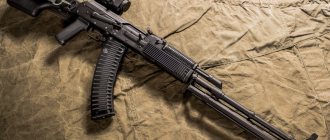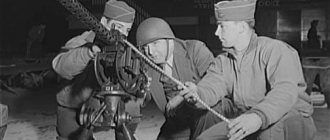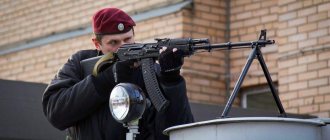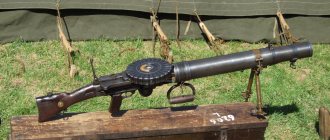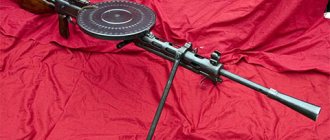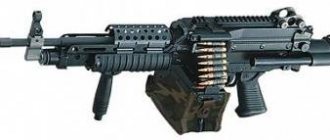Light machine gun
| This article contains inline quotes, but they are not formatted correctly. Please improve this article by correcting them. |
Type of light machine gun
| Type 99 light machine gun | |
| Type 99 light machine gun at the New Brunswick Museum, Saint John, New Brunswick, Canada. | |
| Type | Light machine gun |
| Place of origin | Empire of Japan |
| Service history | |
| In service | 1939–1945 |
| Used | See Users |
| Wars | Second Sino-Japanese War Second World War Indonesian National Revolution Hukbalahap Rebellion [ citation needed ] Korean War Chinese Civil War First Indochina War Vietnam War (limited) |
| Production history | |
| Designer | Kijiro Nambu |
| Designed by | 1939 |
| Produced | 1939–1945 |
| No. built | 53 000 |
| Characteristics | |
| Weight | 10.4 kg (22.9 lb) |
| Length | 1181 mm (46.5 in) |
| Barrel length | 550 mm (21.7 in) |
| Cartridge | 7.7×58mm Arisaka 7.62×54mmR (converted to VPA) [ citation needed ] |
| Caliber | 0.311 in (7.9 mm) |
| Action | Gas |
| Rate of fire | 800 rounds per minute |
| starting speed | 2,346 feet per second (715 m/s) |
| Effective firing range | 2000 m (2200 yd) |
| Maximum firing range | 3,500 m (3,800 yd) (7.7×58mm Arisaka) |
| Feeding system | 30-round detachable box magazine |
Type 99 light machine gun
(九九式軽機関銃, kyukyu-shiki Kei-kikanjū) was a light machine gun used by the Imperial Japanese Army in World War II. [1]
History and development[edit]
A Japanese soldier uses his comrade as an anti-aircraft bipod for his Type 99
US Marines pose with a captured Type 99 with bayonet
The Japanese Army used the Type 96 light machine gun, an improvement over the previous Type 11 light machine gun. The Type 96 entered service in 1936 and quickly established itself as a versatile weapon for covering advancing infantry. [2] Both the earlier Type 11 and current Type 96 light machine guns use the same 6.5x50mmSR Arisaka cartridges as the Type 38 infantry rifle. [3] Using the same ammunition in both guns simplified supply and had the added advantage that any member of the squad could supply ammunition for the light machine gun or vice versa
.
However, in 1939, the Japanese Army switched to a larger and more powerful 7.7 mm cartridge, which also did not have a rim, which improved handling of the cartridge. This more powerful cartridge: 3136 J energy, compared to the earlier Arisaka 6.5x50mm SR: 1966 J energy, required a firearm with more steel, larger springs, and a heavier bolt to handle the additional forces. This required a switch from the Type 38 rifle to the Type 99 rifle, which could handle a more powerful round. Likewise, a new version of the reliable Type 96 light machine gun had to be developed that could also use this new larger caliber; thus, the advantages of conventional ammunition between riflemen and machine gunners could be maintained. The Type 99 light machine gun was produced at the Kokura, Nagoya Arsenal and Mukden factories, with a total of about 53,000 weapons produced. [4]
Ho-103 (101,102,104). Japan
There was a historical anecdote with large-caliber machine guns for Japanese aircraft. The Japanese Air Force, having entered the war in China, immediately thought about the need to strengthen its weapons. And since in terms of development on their own in Japan in those years everything was very bad, the imperial military bowed to the allies.
The Japanese would like to purchase a license for the latest German machine gun MG.131, but were completely refused. The Germans did not dare to take such a step, being somewhat confused. Firstly, Germany in 1939-40 had complete love and understanding with the USSR. Necessary strategic materials flowed like a river from the Soviet Union.
At the same time, the USSR gave Japan a cold shower at Khasan and Khalkhin Gol. And Japan was not such a great supplier. Therefore, in the end, the pragmatic Germans decided not to quarrel with Stalin ahead of time by selling some kind of machine gun to the Japanese.
As a result, the Japanese Air Force was left without a heavy machine gun at all, and this problem could only be solved by 1941. But how... Quite a decent number of American Browning M1921 machine guns were captured in China.
The Japanese, in the best traditions, simply copied the machine gun (not the worst, yes), without bothering with a license at all. But in order not to quarrel with the United States completely and irrevocably, the machine gun was chambered for... the Italian cartridge 12.7x81SR!
The one with the explosive cartridge.
As a result, in 1941, the excellent heavy machine gun No-103 was adopted by the Japanese army (we emphasize) aviation, which fully satisfied the needs of the Air Force, both in offensive and defensive weapons.
The machine gun turned out to be light, compact, reliable and quick-firing (in the wing or turret version). There were also disadvantages. Like all Browning machine guns, it was difficult to synchronize, sacrificing in rate of fire. Plus a weaker Italian cartridge.
But the main drawback was that the machine gun synchronized with the engine in certain engine operating modes reduced the rate of fire from the stated 900 rounds/min to 400! But over time, having rebelled, the pilots of the Nakajima Ki-43 fighters (which were first used by the No-103) became accustomed to using in battle those engine modes that did not reduce the rate of fire.
Almost all Japanese military land fighters were armed with several of these machine guns, both synchronized and wing-mounted. But the Japanese gunsmiths were unable to overcome the drop in the rate of fire.
Advantages: reliability.
Disadvantages: low rate of fire in the synchronized version.
Design[edit]
The Type 99 was essentially the same design as the Type 96 light machine gun, and shared a number of parts. However, it did without an oiler and had better primary recovery, improving reliability over its predecessors. Early models had a single stock rest and a muzzle-mounted flash suppressor that screwed onto the threaded portion of the gun barrel. [3] The curved detachable box magazine located on top held 30 rounds, and the finned barrel could be quickly replaced to avoid overheating. Like its predecessor, the Type 96, the Type 99 bears a clear resemblance to the British Bren gun.
The Type 99 had a paddle front sight and a leaf rear sight, graduated from 200 to 1500 meters with windage adjustment. On the right side of the gun it was possible to install a 2.5X optical sight with a field of view of 10 degrees. [3] They were often issued to the best marksmen in a unit and were sometimes used as a sniper rifle. A standard infantry bayonet could be attached to a gas block under the barrel, but on the battlefield this feature proved inconsequential due to the weight of the gun and the fact that the flash suppressor largely covered the blade when it was attached to the muzzle. . [5]
What were you smoking, samurai?
But perhaps the most outstanding creation of the Japanese technical genius is patent No. 001841 dated February 18, 1936, embodied in metal. Have you ever made carbide bombs with water as a child? Jotaro Endo’s “Shooting Simulator” works on exactly the same principle. The acetylene mixture produced by the generator was supplied through a hose to the valve. The first number of the calculation turned the lever on the right side of the product body and activated a rod made of ferrocerium or magnesium alloy. The rod rubbed against the ratchet and gave a spark, the gaseous explosive mixture went “BOOM!”
It was especially emphasized that as a result, the first number of the rifle crew experienced “almost real” recoil and the sound of a shot. In addition, such a simulator did without cartridges and was therefore much cheaper to operate than its “real-life” counterparts. Of course, there could be no talk of any serious unification of training models (interchangeability of spare parts, etc.) with this approach. There was also no real possibility of converting them into military weapons - the shooting toy remained a toy, and did not help the Japanese troops in any way in 1945.
After the end of the war, “Kyurenkey-Kikandzhiu” would probably have been completely forgotten by the whole world if not for the Americans. Foreigners with a penchant for exoticism took home quite a significant number of “training machine guns” of all kinds as souvenirs.
Combat report [edit]
IJA paratroopers armed with Type 99s during the Battle of Palembang
The Type 99 entered service in 1939 and was used side by side with the older Type 11 and Type 96 as these models were produced in large numbers and many front line troops continued to use the Type 38 with their rifles. Ammunition of 6.5 mm caliber. All three weapons remained in service until the end of the war. [6] The Type 99 was used by communist forces (Chinese and North Korean armies) during the Korean War. [7] It was used by the Viet Minh and North Vietnamese forces during the First and Second Indochina Wars. [8]
Early examples of Japanese rifles
And this story began immediately after the end of the first Sino-Japanese War in 1895, when the Japanese military was finally convinced that the possibilities for modernizing the rifle designed by Major Murata had already been more than completely exhausted. Only 15 years have passed since this model was adopted by the Japanese army, but by the standards of the then explosive progress in the field of firearms, this was already two whole generations ago. Suffice it to say that this rifle began its service as a single-shot rifle chambered for an 11-mm black powder cartridge, then was re-barreled for an 8-mm cartridge, then transferred to smokeless ammunition and, finally, converted into a magazine rifle. In general, it repeated the career of many rifles of that time.
Murata rifle. On top is the 11mm original model arr. 13 (1880), below 8-mm magazine model. 22 (1889)
Users[edit]
| This section requires additional links for verification . |
- Japan [10]
- Philippines
- People's Republic of China
- republic of china
- Indonesia: Used in limited quantities [11]
- North Korea [12]
- Vietnam [8]
Ineffectiveness of the national approach
It would seem that such a number of quite decent “training” samples, the automation of which worked on the principle of blowback, should sooner or later push designers to create submachine guns of a similar design - take it and use it! Moreover, the army’s request for this type of very effective melee weapon has existed for a long time. But, no matter how crazy it may sound, the situation was completely described by a phrase from a sadistic children's joke: “No legs, no cartoons.”
There was no one to create a PP: in the structure of the Japanese army units there was simply no position of a machine gunner and military officials were in no hurry to introduce it. Mass production of submachine guns was established only after 1942, and it was a necessary measure - the Japanese then finally clashed with the Americans in a short battle, and among the Yankees, the Tommy Gun was a very common weapon and perfectly showed its advantages over store-bought ones. rifles.
As a result, the total production of all modifications of the Type 100 SMG was, according to the most optimistic estimates, a pitiful 27 thousand units. The Type 100 did not have a serious impact on the conduct of combat operations; the main personal weapon of the soldier until the end of the war remained a repeating rifle with a manual reloading.
Thus, the Japanese view of the “firearm” (as opposed to the CVP system) showed its ineffectiveness. It's probably for the better.
PS. The author thanks Andrei Tsvershits for his help in creating the material.
Notes[edit]
- ↑
Bishop, Encyclopedia of World War II Weapons. - Meyer, The Rise and Fall of Imperial Japan. p.53
- ^ abc [1] TM-E 30-480 (1945)
- [2] JapaneseWeapons.net
- ^ ab "Archive copy". Archived from the original on 2007-12-13. Retrieved January 4, 2008.CS1 maint: archived copy as title (link) Modern firearms
- ↑
Morse,
Japanese Small Arms of World War II; Light machine guns models 11, 96, 99, 97 and 92 - Kinard, Jeff (2010). "Machine guns". In Tucker, Spencer C.; Pierpaoli, Paul G., Jr. (ed.). Encyclopedia of the Korean War: Political, Social and Military History. 1. A.L. (2nd ed.). ABC-CLIO. p. 535. ISBN 978-1-85109-849-1.
- ^ a b Ezell, Edward Clinton (1988). Personal firepower. An Illustrated History of the Vietnam War 15. Bantam Books. pp. 47-49. OCLC 1036801376.
- McCollum Ian (February 2, 2019). "Firing the Type 99 Nambu in 7.62mm NATO". YouTube (Forgotten Weapons)
. Retrieved December 27, 2022. - "Guns Of The Rising SunGuns Magazine.com - Guns Magazine.com". gunsmagazine.com
. - Bloomfield, Lincoln P.; Leiss, Amelia Catherine (30 June 1967). Managing Local Conflict: A Design Study on Arms Control and Limited War in Developing Regions (PDF). 3
. Massachusetts Institute of Technology. Center for International Studies. p. 92. hdl: 2027 / uiug.30112064404368. - "Mukden Arsenal after World War II". wwiiafterwwii.wordpress.com
. April 3, 2022
b PYUGPYUANRYUU OPKHMKKH SVYARKHE YUPLEIAYKHE YUPAYAYUKSH yNYSPYU, MUTSN KH VYUYARMYU YNLOYUMKH “Chu:ou Ko:gyou KK”, BNGTSKYUBKYELYU MUHANKEE OKNDNBHRSHL ЪONMYAYHL YNMYARPSYRNPNL-NPSFEIMKHYNL TSEMEPYUKNL yHDFKhPN mYULAS (Kijiro Nambu).
oPNEYR YPSOMNYUKHAEPMNTSN YUBHYUOSKELERYU ONKSVHK KHMDEYAホ-100 (“uN” - I ONPЪDYNBSHL MNLEPNL YAEPHH √ NR YAKNBU 大砲 √ Taihō √ OSYU BBHDS RNTsN, VRN ON ЪONMYAYNI KhDEMRKHTHYUZHNMMNI YAHYARELE NPSFHE YUKHAPIU ANKEE 11 LL YAVHRYUKNYAE OSINI). OPH SCHRNL YUPYAEMYUK YNYSPYU ONKSVHK KHMDEYA OPNEIRYU mN-101, YUPYAYEMUK MUTSNY √ mN-102, YU OPNEIR MULAS √ mN-103.
OSKELER Ho-101Koh
ONOSHRYKH ЪONMZHEB ONKSVKhRE HMTNPLYUZHCH N MNBEIYEL MELEZHYNL OSKELERE MG.131 ME SBEMVYUKHYAE SIAOEUNL. mN MU PSAEFE 1939 √ 40 CC. B ъONМХХ MUYARSOKHKN MEINRNNPNE NUKYUFDEMKHE NRMNYEMKHI I TSEPLYUMKHEI, VRN ASHKN YAB'GYUMN I ANEBSHLH DEYARBKHLKH I yayayap MU uYUKUHM TSNKE, YU B SHCHRNR OEPHND BPELEMKH yayap ASHK BUF MSHL YARPURETSKHVEYAYHL YANCHGMKHYNL MYUZHHARAYNI TSEPLUMXX. bOPNVEL, ShRN OPNDNKFYUKNYAE ME DNATSN, MN REL ME LEMEEE, MELZHSH NRYUGYUKHYAE OPEDNYARYUBHRE KKHZHEMGKHCH MU MG.131 OND OPEDKNTsNL RNTsN, VRN OSKELER ЪБКЪРЯЪ MNBEIEYE PUGPYUAN RYNI KH ME ONDKEFHR OPNDYUFYUL GY PSAEF.
b PEGSKERYURE, YUPYAEMYUKSH YNYSPYU X MUTSN NAPIURHKH YABNH BGNPSH Y DPSTSNLS VKEMS NYAH √ TYUHYARAYNI KHRYUKHH, AKYUTSN YANAYARBEMMSHU KHRYUKEMYAYKHU PYUGPYUANRNNY ASHKN DNYAR YURNVMN X ASHKH NMH MU RNR LNLEMR DNYURNVMN OPNTsPEYAKHBMSHLH X OEPEDNBSHLH. oPHLEPMN B RN FE BPEL REUMKHVEYAYKHI NRDEK RYUAYU ЁONMYAYNI KHLOEPUURNPYAYNI YUBKHYUZHKH Koku Hombu NOPEDEKKHKYA I RHONL ASDSYETSN ANEOPHOYUYU. YANAYARBEMMN, BSHANP ASHK ME ANTSUR. pYYAYALYURPHBYUKYULEPHYUMYAYKHI OYURPNM aPYUSMHMTs 50 BMG 12.7×99 LL, MELEZHYKHI LYUSGEP 13×92 SR X KHRYUKEMYAYKHI aPSCHDU 12.7×81 SR, ЪБКЪБЕИЯ БЯ BNCH NVEPEDE YNOKHEI APHRYUMYAINTSN ONKSDCHILNBNTSN OYURPNMY BHYYEPYA. tPYUMZHSGYAYKHI OYURPNM TsNVYHYA 13.2U99, YNRNPSHI SFE DYUBMN BSHOSYAYUKYA TKNRNL YUY 13.2 Type 93 DUFE ME PYYAYALYURPHBYUKYA B YUVEYARBE BYUPHYUMRYU. YULEPKHYUMYAYKHI OYURPNM ONYAVKHRYUKH HGKKHME LNYMSHL, NR MELEZHYNTSN NRYUGYUKHYAE ON BSHYEKHGKNFEMMSHL OPHVKHMYUL KHSHANP NYARYUMNBHKH MY KHRYUKEMYAYNL OYURPNME. b MELYUKNI YAREOEMKH MU BSHANP ONBKKHKN RN, VRN B NRKKHVKHE NR YULEPKHYUMYAYNTSN OURPNMY KHRYUKEMYAYKHI ANEOKHOYUYA YNLOKEIRNBYUKYA PUGPSHBMSHLH OSKILKH, B YUYNI-RN YAREOEM X ONDLEMBIKHI OSIEVMSHI ANEOPOHOYUYA ANKEYETSN YUKHAPIU.
hMFEMEPSH YUPYAEMYUKYU YNYSPYU B YABNEL OPNEYRE BGYKH GYU AYUGS KHRYUKEMYAYHI OSKELER YAYNRRH (Scotti M1933) YUKHAPYU 12.7 LL. KHRYUKEMYAYKHI OSKELER, PUANRYUBKHI MU NYAMNBE TSYUGNNRNRBNDYU ASHK DNYARYURNVMN KETSYKHL H YNLOYURMSHL, NAKYUDYUK OPEYPYUYAMSHLH YUYUYREPHYARKHYULH X BSHYANYNI YAYNPNYARPEKEMN YARECH. ъONMYAYKHE KHMFEMEPSH B OPNEYRE MN-101, YAYNOKHPNBUB LEUUMHYS OSKELERYU, ON YYUYHL-RN OPHVKHMYUL NRYUGYUKHYAE NR NPHTSKHMYUKEMNI KEMRNVMNI ONDUVH KH PYUGPYUANRYUKH B OEPBSCH N VEPEDE RSPEKEMSCH BEPYAKHCH OSKELERY I DKHYAINBSHL LYUTSYUGKHMNL. OPH SCHRNL YASYYYARBNBUKH ON YPYUIMEY LEPE DBE BEPIAHH OSKELERYU mN-101 √ Koh X Otsu. naE ASHKH BSHONKMEMSH DK ONDBHFMSHU SYARYUMNBNY, MN mN-101Koh YNLOKEIRNBYUKYUYAE DBSL PSVYULH "YU-K LYUYAHL" I TsUYERINI ONYAEPEDHME, Yu mN-101Otsu OKHYARNKERMNI PSY NYRIYNI YAN YAOSYAYNBSHL YPCHVYNL.
yuPYAEMYUK B MUTSN PUANRYU MYUD YABNHL OPNEIRNL MN-102, NPHEMRKHPNBUKYA MU PUGPYUANRYUU YNMZHEPMYU APSCHDU. b YABNEL LNMSLEMRYUKEMNL RPSDE dFNPDF vHMM OPEDONKYUTSUER VRN OPNEIR mN-102 AYUGHPNBUKYAJ MU KHRYUKEMYAINL OSKELERE Breda SAFAT YUKHAPYU 12.7 LL, NDMUYN, EYAKH YASDHRE ON MEL MNTSNVHYAKEMMSHL YANUPYUMKHBHLYA TNRNTSPUYUTKHL OPNEYRYU mN-102, YAYNPEE BYAETSN GYU AYUGS ASHK BGUR ANKEE PUMMKHI KHRYUKEMYAYKHI OSKELER Breda LNDEKE 1930 TSNDYU, KHGMYUVYUKEMN BKHMRNBNVMNTSN YUKHAPIU. xMTNPLYUZHHH N OPNEYRE MN-102 ONVRH ME YANUPYUMHKNYAE, HGBEYARMN, VRN YUBRNLYURHYU OSKELERYU PUANRYUKYU MU YNPNRYNL UNDE YARBNKYU. aSHKH PYUGPYUANRYUMSH OYUPYUKKEKEMN DBE BEPEYAHH √ I KEMRNVMSHL OKHRYUMHEL DK YARYUZHNMYUPMSHU SYARYUMNBNY H I DKHYAINBSHL LYUTSYUGKHMNL ELYNYARECH 35 OYURPNMNB DK RSPECE MSHU SYARYUMNBNY.
OSCELER Ho-102 I KEMRNVMNI ONDUVEI
oPNEYRSH mN-101 X mN-102 ASHKKH BSHONKMEMSH B BKHDE OPNRNRKHONB X OPNUNDHKH KHMREMYAKHBMSHE HYAOSHRYUMKH B 1940 √ 1941 TsNDS, MN ASHKH NRBEPTSMSRSH YUPLKHEI B ONKEGS RPEREE CN SVYUYARMHYU YNMYSPYAYU √ BEGDEYASYYETSN TSEMEPYUKYU mulas I OPNEIRNL mN-103.
b NRKHVHE NR YNMYSPEMRNB yHDFKhPN mYULAS BGJK GYU AYUGS YLEPHYUMYAYHI OSKELER Browning .50 l1921. b KSVKHU ЪONMYAYKHU RPYUDHZHHU RNCN BPELEMKH NANKHYAE AEG KKHZHEMGKHH OPNYARN YAYNOKHPNBUB YNMYARPSYZHCH YULEPKHYUMYAYNTSN OSKELERYU. th MYUVYUKS 40-U OSKELER aPYUSMKHMTSYU LNDEKE 1921 TSNDYu SFE YAVHRYUKYA OPNYEDYHL SCHRYUONL B yuLEPHYE. bSHOSYAY EE B yayu ASHK YABEPMSR B ONKEGS ANKEE YANBEPEMMNTSN l2, Y BSHOSYEMMSHE Y RNLS BPELEMKH OSKELERSH YUYRKHBMN OPNDYUBYUKHYAE ON BYAELS LHPS. MainRNPNE YNKKHVEYARBN YPSOMNYUKHAEPMSHU l1921 ASHKN GYUUBYUVEMN ЪONMYAYHLH BNIYAYULH B yKHRYUE KH GMYULEMKHRYU X HYAYKCHVHREKEMN SDYUVMYU YAKHYARELYU ASHKYU OPNYARN YAYNOKH PNBUMYU MULAS AEG NINASHU OPNAKEL. edKHMYARBEMMNE NRKHVHE NR OPNRNRKHOYU GUYKCHVYUKNYAE B OEPEPYUANRYE YYULNPSH OYURPNMMHYU OND KHRYUKEMYAYKHI OYURPNM, Y ONYAYNKEYS OYURPNM ASHK MEYAYNKEIN LEMEE LNMSHL ON YAPYUBMEMHCH I YULEPKHYUMYAHL, RELO YARPEKEASH NPSFKH, YUBRNLYURHYU YNRNPNTsN PUANRYUKYU GYU YAVER YNPNRYNTSN NRYURYU YARBNKYU, MEKHGAEFMN ASH YAMKHGHKYUYAE. vRNASH YNLOEMYAHPNBURE MEDNYARYURNVMSCH SHMEPTSKHCH NRDYUVH LEMEE LNYMNTSN OYURPNMYU, mYULAS OPKHKNYAE OPHLEMHRE DSKEMSHI SAYNPHREKE √ VUYS MU YNMZHE YARBNKYU. oNPNUNBSHE TSYUGSH, BSHUNBDYKHE HG YARBNKYU OPH BSHYARPEKE, LTsMNBEMMN PYYYAKHPYYA B SCHRNI VUYE, BNGDEIYARBNBUKH MU DSKEMSHI YAPEG, RNKYU ETSN MYUGYUD. dPSTSHL YNMYARPSYRKHBMSHL NRKHVHEL NR YULEPKHYUMYAYNTSN OPNRNRKHOYU ЪBKЪKNYAE RN, VRN YAOSYAYNBNI LEUUMKHGL OSKELERYU LSC ASHR NRPETSSKHPNBYUM RYUY, VRNASH NPSFHE LNTSKN PU ANRYURE ME RNKEIN I GYUPSHRNTSN (YUY WITH OPNRNRHOYU) GYURBNPYU, MN H I NRYPSHRNTSN. ondyuvyu KEMRSH ME LNTSKYU ASHRE HGLEMEMYU B ONKEBSHU SYAKNBKHYU, YU OPEDONKYUTSYUKYU RNKEIN GYUBNDYAYSCH LNDKHTHYUZHHCH mN-103Ko (OPYUBYU) X mN-103 nZhS (KEBYU). LYuYAKЪMN-TSKHDPYUBKHVEYAYKHI ASTEP MU YULEPKHYUMZHE ASHK GYULEMEM MU OPSFKHMMSHI √ BHDHLN ЪONMJSH ONYAVKHRYUKH, VRN DK QUYEMKH NRDYUVKH LEMEE LNYNTSN OURPNMYU NASHVMNTSN OPSFKHMMNTSN ASTEPU ASDER DNYURRNVMN. YaRBNK DKHMNI 810 LL KHLEK 7 BKHMRNBSHU KEBNYARNPNMMKHU MYUPEGNB.
ЪONMYAYU BEPYAKH аПУСМХМЦУ NYUGYUKYUYAE ONAEDHREKEL, VRN H ME SDHBHREKEMN, AKYUTSNDYUP GUKNFEMMNLS ONREMZHHYUKS YLEPHYUMYAYNTSN KHNAPERYUREK. KETSYKHI, YNLOYUYRMSHI, MYUDEFMSHI X YAYNPNYARPEKEMSHI OSKELER ASHK OPKHMIR MU BNNPSFEMKHE HLOEPUURNPYAYNI YUBKHYUZHKH YUY MN-103 HKH RHO 1 NYAMECH 1941 TSNDYU. MEKEG, YNMEVMN, YAYUGYURE, VRN S METSN ME ASHKN MEDNYARYURYINB. yYYU X BYA YAHYARELSH aPYUSMHMTSYU, NM I RPSDNL ONDDYUBYUKYA YAHMUPNMHGYUZHHH I KHGPDMNI ONREPEI YAYNPNYARPEKEMNYARKH. th RNLS FE, LEMEE LNYMSHI OYURPNM OH YAPYUBMEMHCH I "PNDMSHL" YULEPHYUMYAYHL YASYYYARBEMMN YAMKHFYUK DSKEMSCH SHCHMEPTSKHCH GYUKOYU.
OSKELER Ho-103
oEPBSHL YYULNKERNL, ONKSVKHBHL MU BNNPSFEMKHE MNBSHY OSKELER, YARUK MNBEIKHI KHYARPEAHREKE MUYYUDGHLYU Ki-43. oPYUBDU, B OEPBSHU YAEPKHYU Ki-43 YNLOKEIRNBYUKYA KHYE NDMHL OSKELERNL MN-103. sYARYUMNBKEMMSHI MYUD DBKHTSUREKEL YPSOMNYYUKHAEPMSHI YAHMUPNMMSHI OSKELER NYAMYUYUKYA YAHMUPNMHGYURNPNL, YNRNPSHI MU NRDEKEMSHU PEFHLYUU PUANRSH LNRNPYU YAMKHGYUK OPYURKHVEYAY HI RELO YARPEKEASH I HYAUNDMSHU 900 BSHYARP/LHM DN NAYAYSPYUFKHBUYEE MHGYKHU 400! KH BRNPNI YAHMUPNMMSHI OSKELER YANUPYUMHRE BKHMRNBNVMNTSN YUKHAPIU √ ANKEE OPHBSHVMSHI X YAYNPNYARPEKEMSHI bHYYEPYA √ RHO 89 LNDEKE 2. BONYAKEDYARBHH, OPYUBDU, KNTSKHYU ANEB BGKYU YABNE KH "UYUASYASH" SFE MEYAKH OUPS MNBSHU 12.7-LL mN-103, YU OKHKNRSH OP KHMNPNBHBHYAE Y MNBNLS NPSFKHCH YARYUPYUKHYAE B ANCH HYAONKEGNBURE NORKHLYUKEMSHE PEFHLSH LNRNPYU, ME YARNKE YASYYYARBEMMN YAYUGSHBUCHYKHEYA MU OYUDEMXX RELOYU YARPEKEASH.
ON LEPE BRTSKHBYUMKH ЪONMKHH B LYANPSAYS rHUNNYEYUMYAYKHU YAPYUFEMKHI, ONRPEAMNYARKH B YPSOMNYUKHAEPMNL YUBHYUOSKELERE PNYAKH. THPLYU “Chu:ou Ko:gyou KK”, ME YAOPYUBKYUYUYAN YAN BYA BNGPYUYARYUBHL NAZELNL GYUYUGNB OEPEDYUKYU MU OPNHGBNDYARBN OSKELERYU TSNYASDYUPYARBEMMSHL YUPYAYUKYUL YNYSPYU X mu TsNЪ, YNRNPSHE YARYUKH NYAMNBMSHLKH OPNKHGBNDHREKLKH mN-103.
oPHLEMEMKHE MN-103 MU YUPLEIYAYKHU YYULNKERYUU ASHKN NVEME LHPNYN. oPYURHVEYAYKH BYAE ЪONMYAYKHE HYARPEAHREKH BNEMMNTSN BSHOSYAYU HLEKH MU BNNPSFEMHH MEYAYNKEIN SCHRKHU OSKELERNB YUY B YAHMUPNMMNL, RYU H B YPSHKEEBNL HYAONKMEMHH. th YANFYUKEMKHCH, YASYYYYARBEMMNE OYUDEMKHE YAYNPNYARPEKEMNYARKH B YAHMUPNMMNL BYUPHUMRE YANOPNBNFDUKN SHRN NPSFHE B REVEMKHE BYAETSN YAPNYU ETSN SHYAOXYURYUZHHH. DUFE ANKEE ONGDMJ PUGPYUANRYU OSYKH MN-5, RUYFE PUGPYUANRYUMMYU MU AYUGE YNMYARPSYZHKH APUSMKHMTSYU, B LEMEYEI YAREOEMKH YARPYUDYUKYU NR SCHRNTSN MEDNYARYURYU.
OSKELER Ho-104
oNRPEAMNYARE B RSPEKEMNL BYUPHYUMRE YPSOMNYYUKHAEPMNTSN OSKELERYU GYYARYUBKHK YHDFKHPN mYULAS BSHOSYARKHRE KH ONDBHFMSCH LNDKHTHYUZHCH, ONKSVKHBSCH NANGMYUVEMHE mN-104. NANPNMHREKEMSHI ONDBHFMSHI mN-104 ONKSVHK OKHYaRNKERMSCH PSYNRYS YAN YAOSYAYNBSHL YPCHVYNL, MEYAINKEIN HGLEMEMMSHI KEMRNOPHELMKHY KH DSKEMSHI SYAYNPHREKE DPSTSNI TNPLSH. OSKELER NYAMYUYUKYA MNBSHL PETKEIRNPMSHL OPHZHEKNL X HMNTSDU YNLOKEYRNBUKYA OKEVEBSHHLH X ONYAMSHLH SONPYULH. boepbshe mN-104 ASHK OPHLEMEM B BEPUMEI AYUYEMMNNI SARYUMNBYE ANLAYUPKHPPNBYKHYU Ki-21-II, YU LYUYANBN MYUVYUK SYARYUMYUBKHBUREYA B YARPEKYNBSHU SYARYUMNBYUU ANLAYUPKHPNBYHYU Ki -49 X Ki-67. oPHLEMKYA RUYFE B NANPNMHREKEMSHU SYARYUMNBYUU RSPLNBKHYU Ki-102 X PЪDE DPSTSKHU YUPLEIAYKHU YYULNKERNB BRNPNI ONKNBKHMSH BNIMSH. UYUPYUREPMN, VRN KHMDEYA RSPEKEMNTSN OSKELERYU mN-104 YYUY-RN ME OPHFHKYAJ B YONMYAYNI YUPLEIYAYNI YUBKHYUZHKH X ONDBHFMSCH LNDKHTHYUZHCH OH MEPZHKH OPNDNKFYUKH NANGMYUVYURE mN -103.
aPNMEANIMN-RPYYAYAHPSCHYHE OYURPNMSH 12.7U81SR DKЪ OSKELERNB mN-103
oYURPNMSH 12.7U81SR DK OSKELERNB mN-103 BSHOSYAYUKHYAE MU rNYHIYAYNL YUPYAYYUKE YAKEDSCHYETSN YUYANPRHLEMRYU:
- хMEPRMSHI, LYUYAYANI 33 Ts., LYUPYKHPPNBUKYA PNGNBSHL YNKEZHNL BNYPSTS YUOYASK MU DNMZHE TSHKEGSH.
- xMEPRMSHI RPYYAYAHPSCHYHI; LYUPYKHPNBUKYA GEKEMSHL YNKEZHNL BNYPSTS YUOYASK MU DNMZHE TSHKEGSH.
- aPNMEANIMN-RPYYAYAHPSCHYHE RPEU PYUGMNBKhDMNYAREI, LYUYAYANI OSKH 35.4 Ts, NRKHVYUKHYAE ZHBERNL RPYYAYASH √ AEKNTsN, YPYYYAMNTsN HKKH VEPEDSCHYKHLYA AEKN-YYYUYAMSHL YAKEDNL; LYUPYHPNBYUKHYAE ZHBERMSHLH YNKEZHYULH BNYPSTS YUOYASK YANNRBERYARBEMMN VEPMSHL HKKH AEKN-GEKEMSHL.
- TSTSYuYAMN-GYUFHTSYUREKEMSHI DBSU BHDNB lyu-102 AEG BGPSHBUREK, DERNMYUZHH YNRNPNTsN OPNHYAUNDHKYU NR SDYUPYU N ZHEKE X lyu-103, YNRNPNL OPHYASRYARBNBUK BGPSHBUREKE. OSKH BEYAHKH 37 TSPULL X YANDEPFYUKH 0.8 Ts. OEMRPHRYU.
Links[edit]
- Bishop, Chris (editors) (1998). Encyclopedia of World War II Weapons
. Barnes and Nobel. ISBN 0-7607-1022-8.CS1 maint: extra text: authors list (link) - Mayer, S. L. (1984). The Rise and Fall of Imperial Japan. Military press. ISBN 0-517-42313-8.
- Morse, D.R. (1996). Japanese small arms from World War II;
Light machine guns models 11, 96, 99, 97 and 92 . Firing Pin Companies. ASIN: B000KFVGSU. - Popenker, Maxim (2008). The Machine Gun: The Development of the Machine Gun from the Nineteenth Century to the Present. Crowd. ISBN 978-1-84797-030-5.
- Rottman, Gordon L. (2005). Japanese infantryman 1937-1945
. Osprey Publishing. ISBN 1-84176-818-9. - US Department of War (1994). Handbook of the Japanese Armed Forces, TM-E 30-480 (1945)
(reprint). Louisiana State University Press. ISBN 0-8071-2013-8.



